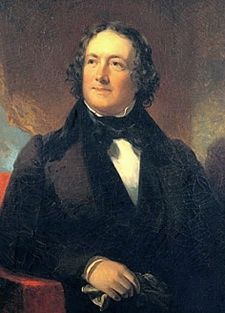Nicholas Biddle
Brown was hardly unusual among the capitalists of the North. Nicholas Biddle's United States Bank of Philadelphia funded banks in Mississippi to promote the expansion of plantation lands. Biddle recognized that slave-grown cotton was the only thing made in the U.S. that had the capacity to bring gold and silver into the vaults of the nation's banks. Likewise, the architects of New England's industrial revolution watched the price of cotton with rapt attention, for their textile mills would have been silent without the labor of slaves on distant plantations.
The story we tell about slavery is almost always regional, rather than national. We remember it as a cruel institution of the southern states that would later secede from the Union. Slavery, in this telling, appears limited in scope, an unfortunate detour on the nation's march to modernity, and certainly not the engine of American economic prosperity.

Yet to understand slavery's centrality to the rise of American capitalism, just consider the history of an antebellum Alabama dry-goods outfit called Lehman Brothers or a Rhode Island textile manufacturer that would become the antecedent firm of Berkshire Hathaway Inc.
Reparations lawsuits (since dismissed) generated evidence of slave insurance policies by Aetna and put Brown University and other elite educational institutions on notice that the slave-trade enterprises of their early benefactors were potential legal liabilities. Recent state and municipal disclosure ordinances have forced firms such as J.P. Morgan Chase & Co. and Wachovia Corp. to confront unsettling ancestors on their corporate family trees.

Such revelations are hardly surprising in light of slavery’s role in spurring the nation’s economic development. America's "take-off" in the 19th century wasn't in spite of slavery; it was largely thanks to it. And recent research in economic history goes further: It highlights the role that commodified human beings played in the emergence of modern capitalism itself.
The U.S. won its independence from Britain just as it was becoming possible to imagine a liberal alternative to the mercantilist policies of the colonial era. Those best situated to take advantage of these new opportunities -- those who would soon be called "capitalists" -- rarely started from scratch, but instead drew on wealth generated earlier in the robust Atlantic economy of slaves, sugar and tobacco. Fathers who made their fortunes outfitting ships for distant voyages begat sons who built factories, chartered banks, incorporated canal and railroad enterprises, invested in government securities, and speculated in new financial instruments.
This recognizably modern capitalist economy was no less reliant on slavery than the mercantilist economy of the preceding century. Rather, it offered a wider range of opportunities to profit from the remote labor of slaves, especially as cotton emerged as the indispensable commodity of the age of industry.

In the North, where slavery had been abolished and cotton failed to grow, the enterprising might transform slave-grown cotton into clothing; market other manufactured goods, such as hoes and hats, to plantation owners; or invest in securities tied to next year's crop prices in places such as Liverpool and Le Havre. This network linked Mississippi planters and Massachusetts manufacturers to the era's great financial firms: the Barings, Browns and Rothschilds.
A major financial crisis in 1837 revealed the interdependence of cotton planters, manufacturers and investors, and their collective dependence on the labor of slaves. Leveraged cotton -- pledged but not yet picked -- led overseers to whip their slaves to pick more, and prodded auctioneers to liquidate slave families to cover the debts of the overextended.
The plantation didn't just produce the commodities that fueled the broader economy, it also generated innovative business practices that would come to typify modern management. As some of the most heavily capitalized enterprises in antebellum America, plantations offered early examples of time-motion studies and regimentation through clocks and bells. Seeking ever-greater efficiencies in cotton picking, slaveholders reorganized their fields, regimented the workday, and implemented a system of vertical reporting that made overseers into managers answerable to those above for the labor of those below.

The perverse reality of a capitalized labor force led to new accounting methods that incorporated (human) property depreciation in the bottom line as slaves aged, as well as new actuarial techniques to indemnify slaveholders from loss or damage to the men and women they owned. Property rights in human beings also created a lengthy set of judicial opinions that would influence the broader sanctity of private property in U.S. law.
So important was slavery to the American economy that on the eve of the Civil War, many commentators predicted that the North would kill "its golden goose." That prediction didn't come to pass, and as a result, slavery's importance to American economic development has been obscured.
But as scholars delve deeper into corporate archives and think more critically about coerced labor and capitalism -- perhaps informed by the current scale of human trafficking -- the importance of slavery to American economic history will become inescapable. (source: Bloomberg)
Wingspan Portfolio Advisors
|





